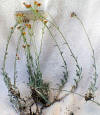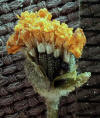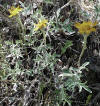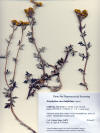|
Trees and
Shrubs of Kern County (Sep 2012, Dec 2013; revised Jun 2016 )
Eriophyllum.
Shrubs, subshrubs, herbaceous perennials, or annuals; stems covered with
woolly hairs; leaves alternate, entire or shallow to deeply divided,
woolly on both surfaces to green on upper surface; flower heads
terminal, involucres with 4–13+ bracts in a single rank, overlapping
along margins (except E. latilobum); ray and disk flowers yellow
(rays white in herbaceous species, rarely absent in perennial species);
cypselae with flattened hyaline scales (rarely absent) shorter than the
pericarpium, appearing irregularly torn along apex (erose); pericarpium
stake-like to club-shaped, curved to straight, flattened to angled,
hairy or glabrous. 13 spp. western North America. Several species
collected from California (E. confertiflorum, E. lanatum)
showed antitumor activity in the NCI screen before 1980; a sesquiterpene
isolated from E. confertiflorum was moderately active in the
P-388 Leukemia assay (Cassady & Suffness 1980). Flowers of E. lanatum
used as a love charm by the Chehalis; leaves rubbed on the face by the
Skagit to prevent chapping (Moerman); “fuzz” of E. confertiflorum
applied to skin to treat rheumatism, scraped off stems using fingernails
into a ball, three fuzz balls placed in succession on the affected
parts, each burned with fire, causing blisters (Jaeger 1941).
The genus Eriophyllum
has been interpreted to include as many as 45 species (Rydberg, Flora
North America 34, 1915), or as few as eleven species (Constance 1937),
many of which were previously treated in other genera (Jepson 1925;
Constance 1937; Abrams & Ferris 1960); including varieties, a total of
157 different scientific names prior to 1937 (Johnson & Mooring, FNA
Vol. 21: 255, 2009). Varieities of E. confertiflorum
distinguished here by arrangement of flower heads more than by their
number (JM2).
Key to Species and Varieties of Eriophyllum
1. Most flower heads
in clusters of 3 or more per stem, on relatively short
peduncles, usually < 4 cm; ray flowers when present commonly 4–6 (-8)
per head.....................................................
........... ............................................ 2
1. Flower heads 1
(solitary), or as many as 3 per stem in E. lanatum var.
grandiflorum, or up to 5 per stem in E. jepsonii, on
longer peduncles,
4–30 cm; ray flowers when present usually 8–13 (rarely 5 in var.
integrifolium, or 4 in E. jepsonii)...............
......................................................... 4
2. Flower heads ± lax
in flat-topped arrays, the heads often separate from one
another, the rays (usually present) of many heads not overlapping with
the
disk of adjacent flowers.... .......... Eriophyllum confertiflorum
var. laxiflorum
2. Flower heads
tightly clustered in ± hemisperhical array, the floral heads
touching one another or rays reaching the disk of adjacent
flowers................... 3
3.
Heads 3–10; leaves opposite below (at least in the type)
...... ................................... ........... Eriophyllum
confertiflorum var. tanacetiflorum
3. Heads 10–30;
leaves all alternate..... Eriophyllum confertiflorum var.
confertiflorum
4. Ray flowers usually
4–8; leaves entirely linear or divided into linear
segments; foothill woodland, reported from Contra Costa to San Benito
counties,
observed and photographed in Kern County on north slope of
Piute Mt, 30 Apr 2005; and on Cerro Noroeste (29 Jun 2016). Eriophyllum jepsonii
4. Rays usually 8–13;
leaves entire, irregularly toothed or divided
into broad segments or lobes.........................................
Eriophyllum lanatum-5
......
...... 5. Leaves opposite below, divided into segments; disk
flowers
bald........... ; Tehachapi Mts; San Emigdio Mts (Windwolves Preserve)
var. hallii
...... 5. Leaves alternate, entire to toothed distally; disk
flowers glandular
or glandular hairy on the tube................... ...........
............................................. 6
6. Ray flowers usually
8; Greenhorn Mts........ Eriophyllum lanatum var.
integrifolium
6. Ray
flowers 9–13............................
.....................................................................
7
7. Leaves becoming
wider from base to mid region or beyond, entire
or shallowly indented, margins not rolled under, gray green,
surfaces equally hairy; occasional, Greenhorn
Mts................................................ ...........
Eriophyllum lanatum var. obovatum
7. Leaves uniformly
narrow or widest at base, entire or deeply divided,
revolute along margins; green or less hairy above.
............................................. 8
8. Disk relatively
broad, nearly equal to length of ray flowers; pappus
< 0.2 mm or absent; Greenhorn Mts......... Eriophyllum lanatum
var. croceum
8. Rays conspicuously
longer than diameter of disk;
pappus 0.5–1.5 mm; not recognized in Kern
County...... ........... ...................................
Eriophyllum lanatum var. grandiflorum
Eriophyllum confertiflorum (Bahia
confertiflora DeCandolle 1836) A. Gray 1883 var.
confertiflorum. Golden yarrow Subshrub with branched
woody stems and erect herbaceous flowering stems; leaves alternate, 3–5
pinnately lobed, green above, whitish hairy below, revolute along
margins. Flowers Apr–Aug, yellow in tightly clustered heads, the arrays
± hemispherical with >10 heads. Fruit: cypselae with a 4-angled
pericarpium 2–3 mm, and with 5 terminal short equal scales ~ 1 mm.
Central Coast Ranges and Sierra foothills south to El Rosario in Baja
California Norte, also in the Channel Islands and on Isla Cedros. Type
from California without specific location. Kern Co.: Common in
the cismontane Upper Sonoran shrubby associations. It occurs east of
the mountains at the head of canyons north of Walker Pass and along the
high ridges north of Cameron” (Twisselmann), 290–2,622 m (CCH). Many
other varieties formerly recognized are also synonyms (Munz 1959) with
the exception of the following, which has not been recognized to occur
in Kern County (JM2, Moe 2016).
Eriophyllum confertiflorum
var. laxiflorum
A. Gray 1884. Similar to the typical variety, stems slender, leaves
generally narrow; flower heads typically in terminal umbellate clusters
of relatively fewer heads (<11) on longer peduncles, 1–3 cm, but here
also interpreted to include variously shortly branched arrays with
longer and shorter peduncles in ± a flat-topped (corymbose) arrangement.
Kern Co.: Common along road margins in woodlands and forest of
the Greenhorn Mts., Kern Canyon, on the north slope of Piute Mts., and
undoubtedly elsewhere.
Twisselmann regarded Eriophyllum confertiflorum var.
laxiflorum as a “form with loose inflorescences that…grows at the
Piute cypress grove on Black Mountain 2.9 miles west of Wofford.” He
cited “T8468,” which in CCH (accessed 25 Jun 2016) include duplicates in
four herbaria, identified var. confertiflorum in SBBG and JEPS,
or only to species in CAS and RSA. The variety has been recognized to
occur in the mountains of Santa Lucia, Tehachapi, and southern
California (Abrams & Ferris 1960), “the heads umbellate or subumbellate”
(Jepson 1925), the type possibly from the Santa Lucia Mts. This has
since been regarded a synonym of var. confertiflorum (Mooring,
FNA 21: 361. 2006); however, it seems appropriate to recognize var.
laxiflorum in view of plants in Kern County that key to var.
tancetiflorum, which reportedly differs in having slightly larger
flowers (Dale & Mooring in JM2). Jaeger (1941) shows an illustration he
referred to as var. laxiflorum that compares favorably with
plants in Kern County in the corymbose arrangement of flower heads.
Taxonomic emphasis on arrangement of flower heads, rather than number
of heads (JM2), might lead to recognizing more varieities; specimens
collected by Douglas and Coulter at BM have the umbellate type, which
may not occur in Kern County.
Eriophyllum
confertiflorum var. tanacetiflorum (E.
tanacetiflorum Greene 1889, “heads 3 to 7, nearly or quite sessile
at the summit of a simple stem”; “rays none.”) Jepson 1925 (“2 ½
ft high; lvs ½ to 1 ½ in long”). In JM2 (Mooring) distinguished from
var. confertiflorum by fewer heads (<11), larger involucres, 3–5
mm diam, and larger disk flowers, 3.5–4.0 mm. Type: “Wooded hills of
Calaveras County, Calif., between Sheep Ranch and Murphy’s. June 1889”
(US: Isotype!, Catalog No.: 47411 Barcode: 00124739). Variety
tanacetiflorum reportedly occurs in the northern and central Sierra
Nevada Range in woodlands within a relatively narrow range of elevation,
600–800 m (JM2). Plants in Kern County, such as observed in the
Greenhorn and Piute mountains, key in the Jepson manuals (JM1, JM2, and
eFlora) to var. tanectiflorum based on flower arrays having fewer
than 10 flower heads and by having longer peduncles, compared to the
typical variety; however, it does not appear to be tanectiflorum
when compared to the type specimen, while other key characters that
involve the size of the flower heads and the flowers themselves, a
difference of 1–2 mm, have not been studied in detail.
The
isotype for var. tanacetiflorum notably differs in several
features from that circumscribed by Abrams & Ferris (1960, a species
variant of E/ jepsonii) and by Mooring in JM2 (2012). These
include opposite leaves below the middle (type), in contrast to entirely
alternate as shown in illustrations for var. confertiflorum
(Abrams & Ferris 1960; JM2, not Jepson 1925), which differences in leaf
arrangement were not mentioned; the disk flowers reported to number from
35 to 75 (Mooring in JM2), when fewer than 20 are evident in the type,
and the longer peduncle–to 2.5 cm, a key character, whereas both
varieties are recognized to have nearly sessile flower heads. The
absence of ray flowers (type), which is considered a variable feature of
the species, is indicated in Abrams & Ferris (1960), but only noted for
var. confertiflorum in Mooring (JM2). This variety has
been found to be an “octoploid,” and thought to be a hybrid between the
typical varieity and E. lanatum (Mooring 2001, JM2).
Eriophyllum jepsonii Greene 1891.
Jepson's sunflower. Similar to the preceding in the unequl pappus,
differing in larger flowers with arrays of 1–5 flower heads on longer
peduncles, 4–14 cm; flowering Apr–May; cypselae with a curved 4-angled
pericarpium 3 mm long, and with unequal scales. Scattered locations
from Inner Central Coast Ranges near Coalinga to South Coast Ranges,
and Piute Mts. Type from Alameda Co., between Arroyo Mocho and Arroyo
Valle. Kern Co. Piute Mt. (Spjut photo, www. worldbotanical.com);
Cerro Noroeste (Mt. Abel).
Apparently of local occurrences.
An image of Eriophyllum jepsonii (Spjut, worldbotanical/eriophyllum.com
from Piute Mt. clearly shows flower heads in arrays varying from one 1
to 5 on peduncles longer than 2.5 cm, and having 5–6 rays per head,
along with white hairy stems and linear leaf segments that are rolled
under and white beneath, all of which agree with E. jepsonii.
The species was originally described as entirely woody but in
JM2 it includes plants woody only near base.
Eriophyllum jepsonii was previously reported in CCH
from near Fort Tejon, Grapevine Creek Watershed, on decomposed granite,
3,300 ft, based on Benson 3599 (POM288348, also in DS),
subsequently identified E. confertiflorum var. confertiflorum.
Another southern collection from Fresno County (Jepson Flora
Project (eds.) 2016.
Jepson eFlora, http://ucjeps.berkeley.edu/IJM.html, accessed
on
June 26, 2016)
is indicated to be questionable. Eriophyllum jepsonii, and also
E. confertiflorum var. tanacetiflorum are considered
“octoploids” (Mooring 2001) within a ± defined geographical range
(Jepson eFlora l.c.), while it also seems conceivable that diploid
individuals could have the same characteristics outside the
geographical octoploid range.
Eriophyllum lanatum (Actinella
lanata Pursh 1814) J. Forbes 1833 var. croceum (Greene
1895) Jepson 1925. Perennial with short woody base extending shortly
along ground before ascending upwards, or stoloniferous; leaves widest
above mid region, 2–5 cm in length, lobed or indented along margins,
especially above mid region, lobes often short, as wide as long, long
tapered to base, abruptly tapered to apex from widest part, green above
(balding with age), white hairy underneath; flowers Apr–Aug, golden
yellow to pale orange, heads on penduncles 8–13 cm, rays 12–13, disk
relatively broad, with 100 or more disk flowers; fruit an achene, pappus
absent or nearly so. Dry pine forests below 6500 ft, Sierra Nevada from
Butte County to Kern County just north Greenhorn Pass. Kern Co.:
CCH—Greenhorn Mts.: just below Sunday Peak, Goeden & Teerink, 12 Jun
1990 (UCR); Portugese Pass Road, 3.0 miles north of Greenhorn Pass,
Twisselmann 23 July 1957 (CAS).
Eriophyllum
lanatum
var. grandiflorum (Eriophyllum caespitosum Douglas ex
Lindley 1828 var. grandiflorum A. Gray 1883) Jepson 1901.
Short-lived perennial < 1m; leaves entire and ± linear to pinnately
divided, 3–8 cm long; flowers May–Jul, yellow; stalk of flower heads
swollen; involucre 8–10 mm; rays 12–13. Dry rocky sites in Valley and
foothill woodland below 6,000 ft; occasional from southern Oregon to Del
Norte and Siskiyou Cos. to Mendocino Co., and common in Sierra Nevada
from Shasta Co. to Mariposa Co., and a notable disjunct record
reportedly once collected on Isla Guadalupe off the coast of Baja
California Norte. Type from Sacramento Valley, CA. Changed by curators
to var. integrifolium.
Eriophyllum lanatum var. hallii
Constance 1934. Fort Tejon woolly sunflower. Perennial with thin
pinnately lobes leaves, opposite below, 2–5 cm long; flowers Jun–Jul,
yellow; involucre 8–10 mm; rays 8–9. Rare, Tehachapi Mts. near Ft.
Tejon, rocky canyon 0.5 mi west of the fort, 3,500 ft (type locality);
5.3 km northeast of Castaic Lake, 3 km south of Pastoria Creek,
north-facing road-cut, 1,295 m (A. Parikh, N. Gale 3130, SBBG in
CCH); San Emigdio Mts., Wind Wolves Preserve, CNPS Chapter Field Trip,
May 11, 2013 (image, worldbotanical.com/Eriophyllum).
Eriophyllum lanatum
var. integrifolium
(Trichophyllum integrifolium Hooker 1833) Smiley 1921. Taprooted
shrub with many stems from base; leaves widest above mid region, entire
to 3–5 lobed, 1–5 gm long, plane to slightly revolute along margins;
heads mostly single on peduncles 3–10 cm; ray flowers usually 8 (5–10);
widely distributed in western US, sagebrush scrub, conifer forests,
alpine fields. Kern Co.: Greenhorn Mts., rare. CCH: 6,004 ft
(Greenhorn Mts., D. F. Howe 1659, SD, previously identified var.
grandiflorum); 5.9 miles east of summit (Hardham, 10 Jun 1957,
CAS).
Eriophyllum lanatum var. obovatum
(Eriophyllum obovatum Greene 1895) H. M. Hall 1907. Common
woolly sunflower. Short-lived perennial with entire to distally
toothed densely woolly leaves, 1–5 cm long; flowers Jun Jul, yellow, in
solitary heads on often swollen peduncles (stalk)) below involucre 7–10
mm high; rays 12–13. San Bernardino Mts. north to the southern Sierra
Nevada. Kern Co.: “Occasional on rocky slopes in the ponderosa
pine forest in the Greenhorn Range, becoming rare in the southern Sierra
Nevada of Tulare County” (Twisselmann), 1,798–2,073 m (CCH), Palmer
7–15, Jun 1888 (US).
References on
Pharmacological Activity in Eriophyllum
Cassady J. & M. Suffness,
1980. Terpenoid Antitumor Agents. In J. Cassady & J. Douros, ed.,
Anticancer Agents Based on Natural Product Models, p. 201–269, Academic
Press, NY.
Kupchan S. M., J. W. Ashmore and A. T. Sneden. 1978. Structure-activity relationships
among in vivo active germacranolides. J. Pharm. Sci. 67(6): 865–867.
|































